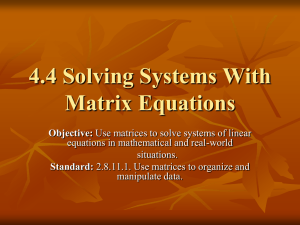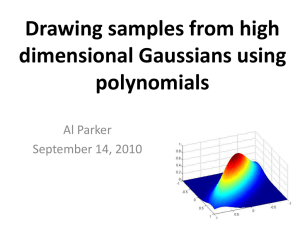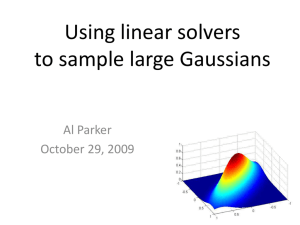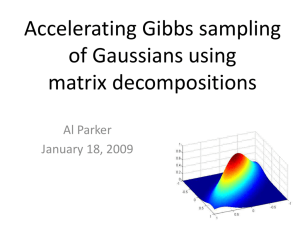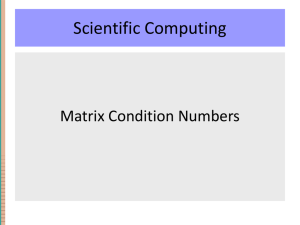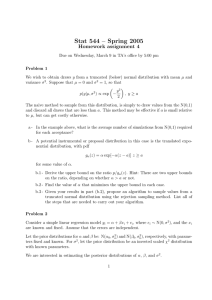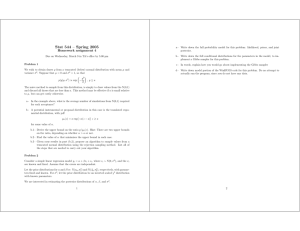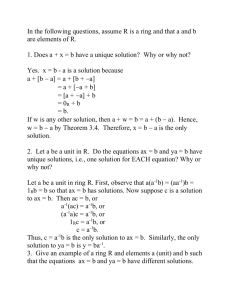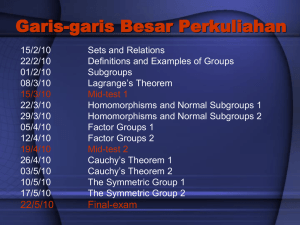Polynomial Accelerated Iterative Sampling of Normal Distributions Al Parker
advertisement
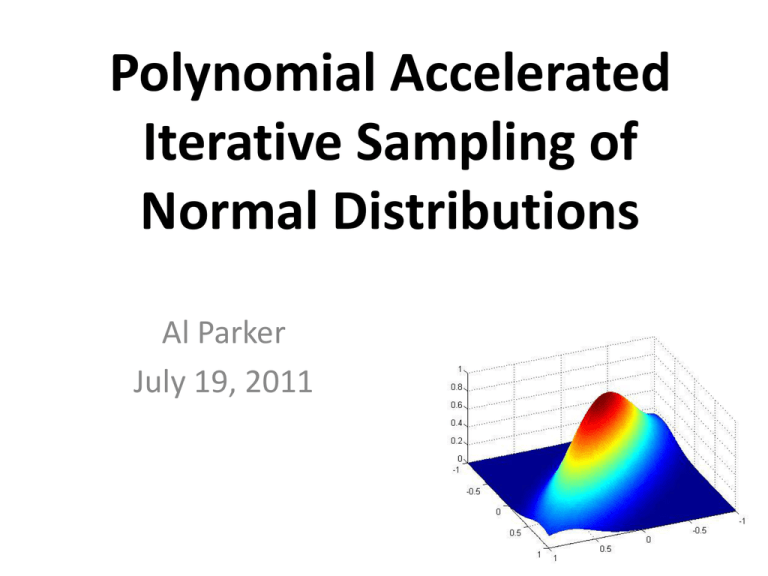
Polynomial Accelerated Iterative Sampling of Normal Distributions Al Parker July 19, 2011 Acknowledgements • Colin Fox, Physics, University of Otago • New Zealand Institute of Mathematics, University of Auckland • Center for Biofilm Engineering, , Bozeman The multivariate Gaussian distribution 1 1 T 1 N ( , ) n exp ( y ) ( y ) 1/ 2 2 det( ) 2 How to sample from a Gaussian N(µ,Σ)? • Sample z ~ N(0,I) y = Σ1/2 z+ µ ~ N(µ,Σ) The problem • To generate a sample y = Σ1/2 z+ µ ~ N(µ,Σ), how to calculate the factorization Σ =Σ1/2(Σ1/2)T ? • Σ1/2 = WΛ1/2 by eigen-decomposition, 10/3n3 flops • Σ1/2 = C by Cholesky factorization, 1/3n3 flops LARGE For Gaussians (n>105, eg in image analysis and global data sets), these factorizations are not possible • n3 is computationally TOO EXPENSIVE • storing an n x n matrix requires TOO MUCH MEMORY Some solutions Work with sparse precision matrix Σ-1 models (Rue, 2001) Circulant embeddings (Gneiting et al, 2005) Iterative methods: • Advantages: – COST: n2 flops per iteration – MEMORY: Only vectors of size n x 1 need be stored • Disadvantages: – If the method runs for n iterations, then there is no cost savings over a direct method What iterative samplers are available? Sampling y ~ N(0,A-1): Gibbs Chebyshev-Gibbs Lanczos Solving Ax=b: Gauss-Seidel Chebyshev-GS CG-Lanczos What’s the link to Ax=b? Solving Ax=b is equivalent to minimizing an ndimensional quadratic (when A is spd) 1 T f ( x) x Ax bT x 2 f ( x) b Ax A Gaussian is sufficiently specified by the same quadratic (with A= Σ-1and b=Aμ): 1 1 T 1 N ( , ) n exp ( y ) ( y ) 1/ 2 2 det( ) 2 CG-Lanczos solver and sampler CG-Lanczos estimates: • a solution to Ax=b • eigenvectors of A in a k-dimensional Krylov space CG sampler produces: • y ~ N(0, Σy ≈ A-1) • Ay ~ N(0, AΣyA ≈ A) with accurate covariances in the same k-dimensional Krylov space Schneider and Willsky, 2001 Parker and Fox, 2011 CG-Lanczos solver in finite precision The CG-Lanczos search directions span a Krylov space much smaller than the full space of interest. CG is still guaranteed to find a solution to Ax = b … Lanczos eigensolver will only estimate a few of the eigenvectors of A … CG sampler produces y ~ N(0, Σy ≈ A-1) Ay ~ N(0, AΣyA ≈ A) with accurate covariances … … in the eigenspaces corresponding to the well separated eigenvalues of A that are contained in the k-dimensional Krylov space Example: N(0,A) over a 1D domain A= covariance matrix eigenvalues of A Only 8 eigenvectors (corresponding to the 8 largest eigenvalues) are sampled (and estimated) by the CG sampler Example: N(0,A) over a 1D domain Ay ~ N(0, A) Cholesky sample CG sample λ -(k+1) ≤ ||A - Var(AyCG)||2 ≤ λ -(k+1) + ε Example: 104 Laplacian over a 2D domain A(100:100) = precision matrix A-1(100:100) = covariance matrix Example: 104 Laplacian over a 2D domain eigenvalues of A-1 35 eigenvectors are sampled (and estimated) by the CG sampler. Example: 104 Laplacian over a 2D domain y ~ N(0, A-1) Cholesky sample CG sample trace(Var(yCG)) / trace(A-1) = 0.80 How about an iterative sampler from LARGE Gaussians that is guaranteed to converge for arbitrary covariance or precision matrices? Could apply re-orthogonalization to maintain an orthogonal Krylov basis, but this is expensive (Schneider and Willsky, 2001) Gibbs: an iterative sampler Gibbs sampling from N(µ,Σ) starting from (0,0) Gibbs: an iterative sampler of N(0,A) and N(0, A-1 ) Let A=Σ or A= Σ-1 1. Split A into D=diag(A), L=lower(A), LT=upper(A) 2. Sample z ~ N(0,I) 3. Take conditional samples in each coordinate direction, so that a full sweep of all n coordinates is yk =-D-1 L yk - D-1 LT yk-1 + D-1/2 z yk converges in distribution geometrically to N(0,A-1) E(yk)= Gk E(y0) Var(yk) = A-1 - Gk (A-1 - Var(y0))GkT Ayk converges in distribution geometrically to N(0,A) Goodman and Sokal, 1989 Gauss-Siedel Linear Solve of Ax=b 1. Split A into D=diag(A), L=lower (A), LT=upper(A) 2. Minimize the quadratic f(x) in each coordinate direction, so that a full sweep of all n coordinates is xk =-D-1 L xk - D-1 LT xk-1 + D-1 b xk converges geometrically A-1b (xk - A-1b) = Gk( x0 - A-1b) where ρ(G) < 1 Theorem: A Gibbs sampler is a Gauss Siedel linear solver Proof: • A Gibbs sampler is yk =-D-1 L yk - D-1 LT yk-1 + D-1/2 z • A Gauss-Siedel linear solve of Ax=b is xk =-D-1 L xk - D-1 LT xk-1 + D-1 b Gauss Siedel is a Stationary Linear Solver • A Gauss-Siedel linear solve of Ax=b is xk =-D-1 L xk - D-1 LT xk-1 + D-1 b • Gauss Siedel can be written as M xk = N xk-1 + b where M = D + L and N = D - LT , A = M – N, the general form of a stationary linear solver Stationary Samplers from Stationary Solvers Solving Ax=b: 1. Split A=M-N, where M is invertible 2. Iterate Mxk = N xk-1 + b xk A-1b if ρ(G=M-1N)< 1 Need to be able to easily solve M y = u Need to be able to easily sample ck-1 Sampling from N(0,A) and N(0,A-1): 1. Split A=M-N, where M is invertible 2. Iterate Myk = N yk-1 + ck-1 where ck-1 ~ N(0, MT + N) yk N(0,A-1) if ρ(G=M-1N)< 1 Ayk N(0,A) if ρ(G=M-1N)< 1 How to sample ck-1 ~ N(0, MT + N) ? M Var(ck-1) = MT + N convergence 0<w< 2/p(A) 2/w I - A Richardson 1/w I Jacobi D 2D - A GS/Gibbs D+L D always SOR/BF 1/w D + L 0<w<2 SSOR/REGS w/(2-w) MSOR D MTSOR (2-w)/w D w/(2 - w) (MSORD-1 MTSOR + NSOR D-1 NTSOR) 0<w<2 Theorem: Stat Linear Solver converges iff Stat Sampler converges Proof: They have the same iteration operator G=M-1N: For linear solves: xk = Gxk-1 + M-1 b so that (xk - A-1b) = Gk( x0 - A-1b) For sampling G=M-1N: yk = Gyk-1 + M-1 ck-1 E(yk)= Gk E(y0) Var(yk) = A-1 - Gk (A-1 - Var(y0))GkT Proof for SOR given by Adler 1981; Barone and Frigessi, 1990; Amit and Grenander 1991. SSOR/REGS: Roberts and Sahu 1997. Acceleration schemes for stationary linear solvers can be used to accelerate stationary samplers Polynomial acceleration of a stationary solver of Ax=b is 1. Split A = M - N 2. xk+1 = (1- vk) xk-1 + vk xk + vk uk M-1 (b-A xk) which replaces (xk - A-1b) = Gk(x0 - A-1b) = (I - (I - G))k(x0 - A-1b) with a different kth order polynomial with smaller spectral radius (xk - A-1b) = Pk(I-G)(x0 - A-1b) Some polynomial accelerated linear solvers … xk+1 = (1- vk) xk-1 + vk xk + vk uk M-1 (b-A xk) Gauss-Seidel vk = uk = 1 Chebyshev-GS vk and uk are functions of the 2 extreme eigenvalues of G CG-Lanczos vk , uk are functions of the residuals b-Axk Some polynomial accelerated linear solvers … (xk - A-1b) = Pk(I-G)(x0 - A-1b) Gauss-Seidel Pk(I-G) = Gk Chebyshev-GS Pk(I-G) is the kth order Chebyshev polynomial (which has the smallest maximum between the two eigenvalues). CG-Lanczos Pk(I-G) is the kth order Lanczos polynomial How to find polynomial accelerated samplers? yk+1 = (1- vk) yk-1 + vk yk + vk uk M-1 (ck -A yk) ck ~ N(0, (2-vk)/vk ( (2 – uk)/ uk M + N) Gibbs vk = uk = 1 Chebyshev-Gibbs vk and uk are functions of the 2 extreme eigenvalues of G Lanczos vk , uk are functions of the residuals b-Axk Convergence of polynomial accelerated samplers E(yk)= Var(yk) = A-1 - Pk(I-G) E(y0) Pk(I-G) (A-1 - Var(y0)) Gibbs Pk(I-G) = Gk Theorem: The sampler converges if the solver converges Fox and Parker, 2011 Pk(I-G)T Chebyshev-Gibbs Pk(I-G) is the kth order Chebyshev polynomial (which has the smallest maximum between the two eigenvalues). (A-1 - Var(yk))v = 0 (A - Var(Ayk))v = 0 for any Krylov vector v CG-Lanczos Pk(I-G) is the kth order Lanczos polynomial Chebyshev accelerated Gibbs sampler of N(0, Covariance matrix convergence ||A-1 – Var(yk)||2 -1 ) in 100D Chebyshev accelerated Gibbs can be adapted to sample under positivity constraints One extremely effective sampler for LARGE Gaussians Use a combination of the ideas presented: • Use the CG sampler to generate samples and estimates of the extreme eigenvalues of G. • Seed these samples and extreme eigenvalues into a Chebyshev accelerated SSOR sampler Conclusions Common techniques from numerical linear algebra can be used to sample from Gaussians • Cholesky factorization (precise but expensive) • Any stationary linear solver can be used as a stationary sampler (inexpensive but with geometric convergence) • Polynomial accelerated Samplers – Chebyshev (precise and inexpensive) – CG (precise in a some eigenspaces and inexpensive)
